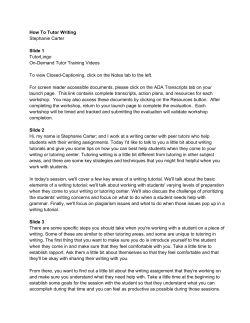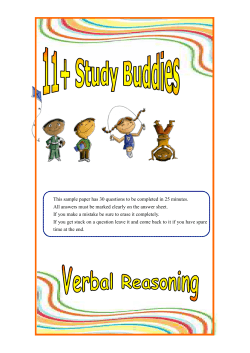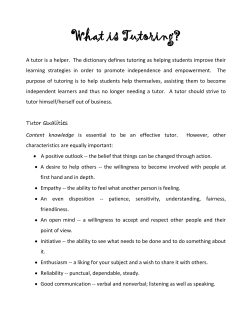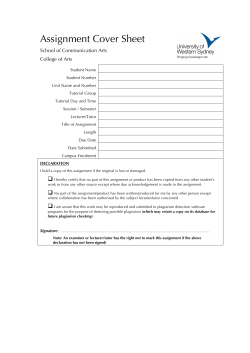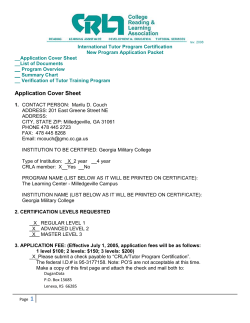
Tutor Protocol Manual 2013-2014 Strategic Content Learning Tutoring Program
Tutor Protocol Manual 2013-2014 Strategic Content Learning Tutoring Program Access and Diversity The University of British Columbia This manual and its contents are copyrighted by Access and Diversity of UBC Table of Contents 1. INTRODUCTION TO THE SCL TUTORING PROGRAM _____________________________ 3 2. ROLES AND RESPONSIBILITIES AT ACCESS AND DIVERSITY _____________________ 3 2.1 ADVISORS _______________________________________________________________ 3 2.2 SENIOR PEER ASSISTANT ____________________________________________________ 4 2.3 TUTORS _________________________________________________________________ 4 3. TRAINING AND COMMUNICATION _____________________________________________ 4 3.1 TRAINING ________________________________________________________________ 4 3.2 COMMUNICATION __________________________________________________________ 4 4. PAYROLL AND TIMESHEETS _________________________________________________ 5 4.1 COMPLETING TIMESHEETS ____________________________________________________ 5 4.2 DUE DATES ______________________________________________________________ 5 4.3 ALLOWABLE HOURS ________________________________________________________ 5 4.4 GETTING PAID ____________________________________________________________ 5 5. THE TUTORING SESSION ____________________________________________________ 6 6. TUTOR-CLIENT CONDUCT ___________________________________________________ 7 6.1 GENERAL CONDUCT ________________________________________________________ 7 6.2 SCOPE OF TUTOR RESPONSIBILITIES ____________________________________________ 7 6.3 APPOINTMENTS ____________________________________________________________ 7 6.4 CANCELLATION POLICY ______________________________________________________ 7 6.5 INTERACTION WITH THE INSTRUCTOR ____________________________________________ 8 7. TUTORING VENUES _________________________________________________________ 8 8. ACADEMIC INTEGRITY ______________________________________________________ 8 9. CONFIDENTIALITY __________________________________________________________ 9 10. CONTACTS _______________________________________________________________ 9 APPENDIX A: SCL IMPLEMENTATION EXAMPLES ________________________________ 10 APPENDIX B: SAMPLE TIMESHEET ________________________ Error! Bookmark not defined. APPENDIX C: CLIENT INFORMATION HANDOUT __________________________________ 11 2 1. Introduction to the SCL Tutoring Program The goals of Access and Diversity (A&D), are to: • remove barriers and provide opportunities for academic success. • provide equal access to University services, programs, and facilities. • ensure fair and consistent treatment of all students. • create a welcoming environment to foster active participation in the UBC community. Peer tutoring is one of the programs run by A&D that helps fulfill these goals. Tutoring works to reduce barriers for students with disabilities and foster their academic success. Tutoring interactions should be welcoming and inclusive, and all clients and tutors should be able to expect fair and consistent treatment. A&D tutors work with the Strategic Content Learning model of tutoring. Unlike most tutoring, which simply re-teaches difficult sections of course content, SCL tutoring equips students with strategies to manage their own learning. The tutor’s role is to support and guide the client through the processes of identifying, developing and applying specific strategies to the learning challenges faced. SCL tutoring follows four basic steps, which the client and tutor undertake together. • • • • First, analyze task requirements: what is the assignment or the area of difficulty? Can it be broken down into simpler tasks or concepts? Second, select strategies to use: how does the client normally approach a task like this one? What has worked or not worked in the past, and what might work this time? Third, monitor the process: keep track of what is being done and successes and challenges along the way Finally, evaluate strategies: what worked? What didn’t? What can be done differently next time? For more information about the SCL method, see Appendix A - SCL Implementation Examples or contact a Senior Peer Assistant. 2. Roles and Responsibilities at Access and Diversity 2.1 Advisors Access and Diversity Disability Advisors work one-on-one with students with documented disabilities to ensure their full access to education at UBC. A&D Advisors determine the accommodations to which a client is entitled (hours per week of tutoring, time extensions for writing exams, adapted course materials or computer software, etc.) and assist clients in accessing these accommodations. The A&D Advisor is the client’s first line of response and support; if a client comes to you with problems outside the scope of tutoring, refer the client to their assigned advisor. 3 2.2 Senior Peer Assistant The Senior Peer Assistant works with the Program Coordinator, Ruth Warick, to coordinate and manage the tutoring program. The Senior Peer Assistant matches clients with tutors using the clients’ tutor request forms and the roster of tutors. The Senior Peer Assistant also participate in the training and monitoring of tutors, and are the main point of communication between A&D and the tutors. If you have any questions about your role as a tutor or any aspect of the tutoring program, contact the Senior Peer Assistant. Senior Peer Assistant e-mail: access.tutors@ubc.ca 2.3 Tutors Tutors assist Access and Diversity clients in developing strategies and mastering content to overcome barriers they face to learning in their UBC courses, stemming from their documented disabilities. All tutors are trained in the Strategic Content Learning model. 3. Training and Communication 3.1 Training • All tutors must attend an “Effective Tutoring; Effective Learning” training workshop. To arrange a training session please contact the Senior Peer Assistant at access.tutors@ubc.ca • Tutors are expected to read and become familiar with the contents of this manual. • Tutors must audio-tape one of their tutoring sessions and submit it to a Senior Peer Assistant, in order to obtain feedback regarding proper implementation of the SCL method of tutoring. The purpose of this exercise is to provide helpful feedback, rather than to evaluate job performance. 3.2 Communication • The primary means of communication with the Senior Peer Assistant is via e-mail. Please provide an up-to-date e-mail address and check it regularly. • Please communicate promptly: respond to all e-mail or phone messages within two days. 4 4. Payroll and Timesheets 4.1 Completing Timesheets Blank timesheets are available from Access and Diversity’s Crane Library in room 1253 Brock Hall, and online at http://students.ubc.ca/access/drc.cfm?page=assistants&view=timesheets. On your timesheet, indicate the number of hours worked on each day. At the bottom of the sheet, total the number of hours for the pay period. Ensure that your name, address, phone number, student number and social insurance number are clearly written in the appropriate space. Your signature and date of signing should appear at the end of the form. See Appendix C, Sample Timesheet, for clarification. Please also note “no-show” appointments on your time sheet. If the client did not contact the tutor to cancel in advance, you may claim for 30 minutes. Timesheets must be signed by clients to be processed. The signature is an auditing procedure in place to reconcile submitted billable hours with actual time worked. If you have more than one client, use a different timesheet for each client to maintain confidentiality. 4.2 Due Dates Time sheets must be physically submitted, not faxed, to Crane Library, Room 1253 Brock Hall, no later than 4:00 p.m. on the due date. Payroll due dates may change each month, but they are always clearly noted on the time sheet. Late submissions are discouraged because of the associated high cost of producing an off-cycle cheque. 4.3 Allowable Hours A&D Student Assistants may have several clients or have multiple positions with A&D, such as tutoring or note-taking. Combined hours must not exceed 10 hours per week (Monday to Sunday). This maximum per week is in effect even when the payroll cut-off date occurs in the middle of the week. Each A&D tutoring client is allotted a certain number of hours per week, determined with an advisor. This is a maximum: it does not have to be met each week, but may not be exceeded. Hours may not be banked from one week to the next – if a client is allotted two hours per week but only uses one hour, the tutor may not spend three hours the next week to make up the time. If your clients believe that they require more time per week, they must contact their A&D Advisor for a possible re-assessment. 4.4 Getting Paid All tutors are to be paid through direct deposit. To set up direct deposit, print and fill out the form at www.finance.ubc.ca/payroll/forms/dirdeposit.pdf and submit it to the direct 5 deposit box at the reception desk in Crane Library (Room 1253 Brock Hall Annex) If you are relying on this part-time position for the monetary support, please keep in mind that due to the personalized nature of the program, client-tutor relationships are always subject to change (particularly in terms of hours worked).. 5. The Tutoring Session Each tutoring session will be tailored to the individual needs and goals of the client. However, following a general pattern may help ensure that your clients get the most out of their tutoring time, and that you feel confident and prepared for each session. Getting Started A tutoring session should begin with casual conversation to give the tutor and client a sense of each other’s mood, thoughts and priorities for the day. For example, asking the client, “How’s it going?” and receiving the response, “Terrible! I have an exam in three hours and I’m so stressed out!” will give the tutor a hint about what to tackle first in the session. Keep this conversation brief – chatting should not cut into tutoring time Follow-up To maintain continuity and build on accomplishments, it is a good idea to briefly review what happened last session. It is helpful to ask clients what they recall from the last session in order to find out whether they would like more review or are ready to move on. Set Session Objectives This step is as simple as asking the client, “What would you like to work on today?” Though it may be within your role to help clients prioritize their schoolwork, this should never mean setting the objectives for them. If this client in the example above requested to work on a written assignment due in two weeks, instead of the exam, the tutor might be inclined to suggest preparing for the exam instead. However, the client may prefer to work on something unrelated in order to reduce the level of stress. Be sure to ask clients why they set their goals and priorities, and help them establish plans to meet these goals. Work Together At this stage, appropriate steps of the SCL method should be applied to chosen objectives of the session. When beginning to work on a new assignment or other new challenge, start by analyzing the task. Then, develop strategies to approach the task. In subsequent sessions, monitor the client’s progress with these strategies, and evaluate them once the task is complete. Wrap Up Together, summarize what was accomplished during the session. Decide whether the client will do any “homework” or preparation for the next session. Talk briefly about the next session’s objectives. These steps are offered as guidelines to help you structure tutoring sessions. Feel free to 6 modify or adapt them to fit the unique tutoring situations and challenges you encounter. 6. Tutor-Client Conduct 6.1 General Conduct The tutor-client relationship is a professional, working relationship. A friendly and comfortable rapport can make the learning experience more effective, but socializing should be kept to a minimum during tutoring appointments. Tutors and clients should maintain an arms-length and respectful relationship. Sexual, racial and/or physical harassment by either party will not be tolerated. If you are concerned for any reason about conduct between yourself and a client, please contact the Senior Peer Assistant. 6.2 Scope of Tutor Responsibilities Tutors working with the SCL model have a very specific role and should not, on their own initiative or at the request of the client, go beyond this role. A tutor is not a replacement for classroom instruction and should not attempt to introduce material not covered by the professor. A tutor is not a note-taker for the student and should not provide class notes. Nor is a tutor expected to complete assignments for the client or provide course content if the client missed a class. It is, however, within the scope of the tutor’s duties to provide instruction to the client on how to develop strategies to independently undertake these tasks. A tutor is also not a counsellor. A client may experience stress, anxiety or distress over academic challenges and difficulties. UBC Counselling Services can support students with these and any other emotional, psychological or mental health issues. Contact a Senior Peer Assistant if a client persists in requesting that you go beyond the scope of your tutoring role, or if you are unsure where to draw the boundaries of your role. 6.3 Appointments Substantive interaction between yourself and your client should be confined to prearranged appointments. It is not appropriate for your client to call upon you to answer “quick questions” outside of prescribed learning times, and doing so interferes with the SCL model. This is especially important when the tutor and client are in the same class or would otherwise regularly encounter each other on campus. Telephone and e-mail communication should be used for arranging appointments, not for answering courserelated questions. 6.4 Cancellation Policy If an appointment must be cancelled, tutors and clients should make every effort to provide notice to each other before the appointment time. In the event that a client does not show up for a scheduled appointment, tutors are to wait fifteen minutes to ensure that the client is not simply running a bit late. Record 15 minutes of billable time on your time sheet, with 7 a note that it was a no-show. Advise a Senior Peer Assistant of this as soon as possible. If for any reason you feel your tutor-client relationship should be terminated, please express these concerns to the Senior Peer Assistant as soon as possible so that appropriate arrangements may be made. The tutor is not permitted to personally cancel his/her relationship with the client as this is the role of the Senior Peer Assistant and the Senior Advisor - Disability with Access and Diversity. 6.5 Interaction with the Instructor It is not appropriate for a tutor to interact with the client’s professor/instructor. A tutor who is also a UBC Teaching Assistant may not mark the examinations or papers of a student who is their client. 7. Tutoring Venues Tutoring should be conducted in a safe, public area. Here are some general guidelines: It is a strict policy that tutoring must take place on UBC campus. Other people should be in the general vicinity. If a location is likely to be completely empty and isolated, it is not an appropriate spot for tutoring. • Empty classrooms are appropriate as long as doors are left open. • Some people prefer silence when studying; others prefer soft background noise. Talk to your clients about their preferences. • Keep confidentiality in mind: a client may not feel comfortable disclosing disability-related learning challenges when peers may overhear. Finding a location that combines privacy and quiet with safety in a public setting can be tricky. Here are some suggestions – talk to your clients about what works for them: • • • • • • • • • • • Classrooms during regular building hours, with doors open. Crane Library (a part of A&D). Group study areas in the libraries (see www.library.ubc.ca/home/respoints.html). Common study rooms in UBC residences. Couch areas on the second floor of the SUB. Study areas in faculty buildings, e.g. Forestry, LSK or Woodward. Tutor or client’s faculty reading room. Student lounges such as Meekison Arts Students’ Space (MASS) in Buchanan D. A non-licensed café or restaurant on campus. 8. Academic Integrity Where any work of the client is subsumed in whole or in part by the thoughts of the tutor, both parties are subject to an allegation of plagiarism. Tutors and clients are often surprised by the range of activities categorized as plagiarism. This may include: 8 • • • • Suggesting the topic for a client’s paper or assignment. Correcting grammar, spelling and/or punctuation in a written assignment. Completing problems on an assignment handed in. Completing research for the client. This is a difficult issue with a lot of grey area. To avoid compromising your or your clients’ academic integrity, take care not to do the work for an assignment that the client will be handing in. For mathematical and science courses, for example, use sample questions, change the facts or variables in an assigned question, and practice applying rules to other contexts. For other assignments, review old assignments or papers; if working on the paper ensure that all of the work is the client’s own work. Tutors should report any occurrences or suspicions of academic dishonesty to the Senior Peer Assistant. For further information please visit www.vpacademic.ubc.ca/integrity/policies.htm. 9. Confidentiality The BC Freedom of Information and Protection of Privacy Act protects the privacy of personal information in the custody or under the control of a public body such as UBC. Personal information is any recorded information that uniquely identifies a person, such as their name, address, telephone number, age, sex, race, religion, sexual orientation, or disability. Tutors must not give out any information about their clients to a third party. Such information includes, but is not limited to, clients’ names and information about their disabilities. Tutors will not be given any information about their client's disability. 10. Contacts If you have any questions about your role as a tutor, do not hesitate to contact a Senior Peer Assistant. The Senior Peer Assistants’ office is located in Brock Hall, room 1262. Weekly hours are posted on the door, or you can make an appointment. Contact the Senior Peer Assistant at: e-mail: access.tutors@ubc.ca or call (604) 822-6233 Questions about timesheets and payroll may be directed to access.diversity@ubc.ca or (604) 822-3757. General questions about the program may be directed to Ruth Warick, Program Coordinator, at ruth.warick@ubc.ca or (604) 822-6233. 9 APPENDIX A: SCL IMPLEMENTATION EXAMPLES Interaction Description Example 1: Guiding a Client to Analyze the Task A client working on writing as part of a pre-college English course. (Reading directions for assignment) S: Okay, okay, I have to write an essay on Nicholas Nickelby… T: What’s in the directions that may help you figure out what it is you will need to do? S: Um…I don’t know… T: What do they want you to write about? You might want to look here to see what they want you to do. S: Yeah… okay… I have to write a character summary… hmm… It has to have all these things in it (points out the list of items to consider). Example 2: Guiding a Client to Develop a Strategy A client completing an academic upgrading program focusing on mathematics. T: Okay so you’ve completed the first two steps to that problem. You’re doing just great. Now, how would you proceed from here? (pause) Would it be helpful to look back in your text to help? S: Yeah, I guess it would… I guess I could look back at the example… that might help me figure it out… T: Good, that sounds like a good plan… Example 3: Building on the Client’s Understanding A client working on writing a history paper. T: So, know that you’ve done your research and you have a good idea of what you want to write about, we’ve got to figure out how to put all that together and how to structure the paper you’re going to write. S: Um, okay… where do I start? Usually I just start writing at the beginning and keep writing until I have written everything out. But when I do that, my thoughts get all jumbled and I repeat myself. T: Would it be helpful to start by writing down some notes and creating an outline? S: Yeah, I could try that… I could go section by section, by time period. T: Good idea; sounds like that could help. Example 4: Supporting Client’s Reflection on Strategies A client working on writing. T: So, your current strategy is to write down all your ideas first, then rearrange them into a more clear order? S: Yeah, yeah. It helps if I can get down everything I want to say before I start editing and fixing it up. T: OK, how’s that working on this paper so far? S: Well, it takes a while, because I write it, then re-write it, so many times. But the paper comes out pretty good in the end. Maybe if I take my time in the first stage, I won’t have to do so many re-writes. T: Hm, that sounds like a good idea. You could always try that, and change your strategy again if it doesn’t work for you. Example 5: Playing a Supportive Role A client working on studying skills. S: I really wanted to show this to you… When I’m doing my note cards, I list all the topics on this side and key words on this side. T: Good. Those look really great! Is that strategy helping? S: Yeah, it’s a lot of work, but I did get a great mark on my quiz! Types of Support Guiding Guiding Guiding, Supporting Guiding - cueing Supporting Guiding Guiding Supporting Clarifying Clarifying Supporting Supporting APPENDIX C: CLIENT INFORMATION HANDOUT Information for Clients - Strategic Content Learning Tutoring Program Strategic Content Learning (SCL) tutoring is offered by Access and Diversity. Through the program, one-on-one SCL tutoring is provided on a weekly basis. Students interested in the program should contact their A&D Advisor. There is no charge for SCL tutoring. The SCL model was developed based on research by Dr. Deborah Butler of UBC’s Faculty of Education. SCL encourages students to make a conceptual shift from direct content learning to activities that teach one to acquire the strategies necessary for understanding the material and how to learn it. What is SCL? SCL tutoring follows four basic steps. 1. Analyze the task: What is the assignment or the area of difficulty? Can it be broken down into simpler tasks or concepts? 2. Strategize: How do you normally approach a task like this one? What has worked or not worked in the past, and what might work this time? 3. Monitor: Check in regularly to keep track of progress and reflect on your learning. 4. Evaluate: Are the strategies you are using effective? Are any changes needed? Who are SCL tutors? What do they do? SCL tutors are UBC students who are trained to guide and support the learning of other students. SCL tutors are matched with clients who have a similar academic focus so that they can understand the tasks and challenges of their clients. The role of SCL tutors is not to teach course content. It is to facilitate clients’ decision making, to actively guide by asking questions, and to support clients’ reflections on their learning processes. What can SCL tutoring do for me? SCL tutors work with clients on learning skills, including: • effective note-taking • memory retention and retrieval • exam preparation and test-taking strategies • study skills • reading and writing skills • time management These skills can enable you to succeed in any academic setting. As an SCL client, what is expected of me? The SCL model is student-directed. You will be expected to come prepared for each session with the necessary materials, to set goals and to make the decisions about your learning. Your tutor can facilitate your decision-making processes, but the final decisions are up to you. 11 SCL TUTORING PROGRAM: GUIDELINES 1. Conduct: The tutor-client relationship is a professional, working relationship. A friendly and comfortable rapport can make the learning experience more effective, but socializing should be kept to a minimum during tutoring appointments. Tutors and clients should maintain an arms-length and respectful relationship. Sexual, racial and/or physical harassment by either party will not be tolerated. 2. Scheduling and Cancelling Appointments: You and your tutor will arrange a schedule based on your allotted maximum hours per week and your goals and needs. If an appointment must be cancelled, tutors and clients should make every effort to provide at least 24 hours notice to each other. Tutors are instructed to wait only 15 minutes when clients do not show up for a scheduled appointment; clients should do the same. If your tutor is regularly late or misses appointments, please contact the Senior Peer Assistant. 3. Role of the tutor: Your tutor cannot interact with your professor/instructor on your behalf. Tutors who are clients’ TAs will not mark clients’ assignments or exams. It is not appropriate for you to call upon your tutor to answer “quick questions” outside of prescribed learning times. To do so goes beyond the scope of the tutor’s responsibilities and prevents the full implementation of the SCL method of tutoring. 4. Tutoring venues: Tutoring should be conducted in a safe, public area, on UBC campus. other people should be in the general vicinity – a faculty building might be appropriate during the day, but after hours when no is around, it is not. Let your tutor know whether you have any preferences as to noise level, privacy, or location. Possible locations include group study areas in libraries, empty classrooms with the door left open, and student lounges. Inappropriate locations include private residences, licensed establishments, and classrooms with closed doors. 5. Academic Integrity and Plagiarism Where any work of the client is subsumed in whole or in part by the thoughts of the tutor, both parties are subject to an allegation of plagiarism. Tutors and clients are often surprised by the range of activities officially considered plagiarism. These include: • Suggesting the topic for a client’s paper or assignment. • Correcting grammar, spelling and/or punctuation in a written assignment. • Completing problems on an assignment that will be handed in. • Completing research for the client. To avoid any possibility of academic dishonesty, and to properly apply the SCL model, clients and tutors could work on sample questions and past assignments. Clients should ensure that all of the work of assignments that will be handed in is their own. Note: We will keep your disability information confidential; it is your choice whether you wish to share with your tutor the nature of your disability and the functional impacts it has on learning. You are invited to book an appointment and discuss this method with a Senior Peer Assistant by e-mailing access.tutors@ubc.ca. To enter the SCL tutoring program as a client, contact your A&D advisor by phoning (604) 822-5844. 12
© Copyright 2025
